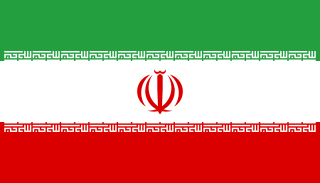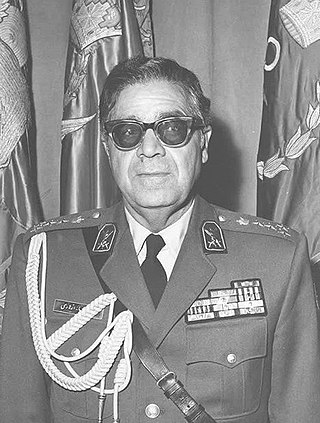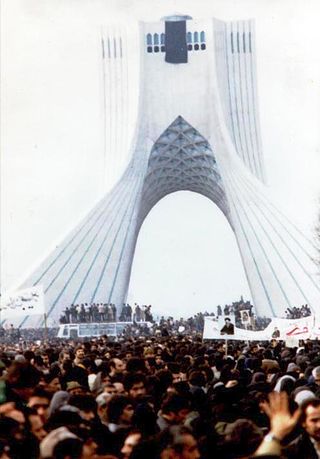| |||||
| Decades: | |||||
|---|---|---|---|---|---|
| See also: | Other events of 1978 Years in Iran | ||||
Events from the year 1978 in Iran.
| |||||
| Decades: | |||||
|---|---|---|---|---|---|
| See also: | Other events of 1978 Years in Iran | ||||
Events from the year 1978 in Iran.

The Iran national football team, recognised by FIFA as IR Iran, represents Iran in international senior football and is governed by the Football Federation Islamic Republic of Iran (FFIRI).

The Iranian Revolution, also known as the 1979 Revolution and the Islamic Revolution, was a series of events that culminated in the overthrow of the Pahlavi dynasty in 1979. The revolution also led to the replacement of the Imperial State of Iran by the present-day Islamic Republic of Iran, as the monarchical government of Mohammad Reza Pahlavi was superseded by the theocratic government of Ayatollah Ruhollah Khomeini, a religious cleric who had headed one of the rebel factions. The ousting of Pahlavi, the last Shah of Iran, formally marked the end of Iran's historical monarchy.

Black Friday is the name given to an incident occurring on 8 September 1978 in Iran, in which 64, or at least 100 people were shot dead and 205 injured by the Pahlavi military in Jaleh Square in Tehran. According to the military historian Spencer C. Tucker, 94 were killed on Black Friday, consisting of 64 protesters and 30 government security forces. The deaths were described as the pivotal event in the Iranian Revolution that ended any "hope for compromise" between the protest movement and the regime of Shah Mohammad Reza Pahlavi.

Seyyed Ali Hosseini Khamenei is an Iranian Twelver Shia marja' and politician who has served as the second supreme leader of Iran since 1989. He previously served as third president of Iran from 1981 to 1989. Khamenei is the longest-serving head of state in the Middle East, as well as the second-longest-serving Iranian leader of the last century, after Shah Mohammad Reza Pahlavi.

Mohammad-Reza Shajarian was an Iranian singer and master (Ostad) of Persian traditional music. He was also known for his skills in Persian calligraphy and humanitarian activities. Shajarian started his singing career in 1959 at Radio Khorasan, rising to prominence in the 1960s with his distinct singing style.

Sharif University of Technology is a public research university in Tehran, Iran. It is widely considered as the nation's most prestigious and leading institution for science, technology, engineering, and mathematics (STEM) fields.

Reza Pahlavi, Crown Prince of Iran is the oldest son of Mohammad Reza Pahlavi, the last Shah of Iran, and his wife Farah Diba. Before the Islamic Revolution in 1979, he was the crown prince and the last heir apparent to the throne of the Imperial State of Iran. Today, Pahlavi resides in Great Falls, Virginia.

Jafar Sharif-Imami was an Iranian politician who was prime minister from 1960 to 1961 and again in 1978. He was a cabinet minister, president of the Iranian Senate, president of the Pahlavi Foundation and the president of the Iran chamber of industries and mines during the reign of Shah Mohammad Reza Pahlavi.

Arteshbod Gholam Reza Azhari was an Iranian military leader who served as the 39th and penultimate Prime Minister of Iran under the reign of Mohammad Reza Pahlavi.

Mahmoud Ahmadinejad is an Iranian principlist and nationalist politician who served as the sixth president of Iran from 2005 to 2013. He is currently a member of the Expediency Discernment Council. He was known for his hardline views and nuclearisation of Iran. He was also the main political leader of the Alliance of Builders of Islamic Iran, a coalition of conservative political groups in the country, and served as mayor of Tehran from 2003 to 2005, reversing many of his predecessor's reforms.

This article is a timeline of events relevant to the Islamic Revolution in Iran. For earlier events refer to Pahlavi dynasty and for later ones refer to History of the Islamic Republic of Iran. This article doesn't include the reasons of the events and further information is available in Islamic revolution of Iran.

From the Imperial Pahlavi dynasty, through the Islamic Revolution (1979), to the era of the Islamic Republic of Iran, government treatment of Iranian citizens' rights has been criticized by Iranians, international human rights activists, writers, and NGOs. While the monarchy under the rule of the shahs was widely attacked by most Western watchdog organizations for having an abysmal human rights record, the government of the Islamic Republic which succeeded it is considered still worse by many.

Mohammad Reza Pahlavi, commonly referred to in the Western world as Mohammad Reza Shah, or just simply The Shah, was the last monarch of Iran. He began ruling the Imperial State of Iran after succeeding his father Reza Shah in 1941 and remained in power until he was overthrown by the 1979 Iranian Revolution, which abolished the country's monarchy and established the Islamic Republic of Iran. In 1967, he took up the title Shahanshah and held several others, including Aryamehr and Bozorg Arteshtaran.

Casualties of the Iranian Revolution refers to those who lost their lives during the Iranian Revolution. Observers differ on how many people died during the Iranian Revolution. The current Islamic government uses the figure of 60,000 killed; in reference to this figure, the military historian Spencer C. Tucker notes that "Khomeini's regime grossly overstated the revolution's death toll for propaganda purposes". The sociologist Charles Kurzman, drawing on later more detailed records from the Islamic Republic, believes the number was closer to 2,000-3,000.
Events in the year 2011 in the Islamic Republic of Iran.

Farah Pahlavi is the widow of the last Shah of Iran, Mohammad Reza Pahlavi, and was successively Queen and Empress of Iran from 1959 to 1979. She was born into a prosperous family whose fortunes were diminished after her father's early death. While studying architecture in Paris, she was introduced to Mohammad Reza at the Iranian embassy, and they were married in December 1959. The Shah's first two marriages had not produced a son—necessary for royal succession—resulting in great rejoicing at the birth of Crown Prince Reza in October of the following year. Farah was then free to pursue interests other than domestic duties, though she was not allowed a political role. She worked for many charities, and founded Iran's first American-style university, enabling more women to become students in the country. She also facilitated the buying-back of Iranian antiquities from museums abroad.

1979 Revolution: Black Friday is an adventure interactive drama video game developed and published by iNK Stories, with assistance from by N-Fusion Interactive. It was released for OS X, Windows, and Android and iOS devices in 2016, and for the Nintendo Switch, PlayStation 4, and Xbox One in 2018. The player controls Reza Shirazi, an aspiring photojournalist, who returns to Iran amidst the Iranian Revolution. As he becomes more involved in the events of the Revolution, Reza is forced to make decisions in order to survive. The player make timed responses throughout the game, determining the outcome of the plot. They are tasked with taking in-game photographs of their surroundings, and given historical background of the events.

Fashion in Iran has a cultural and economic impact on the county of Iran. During the Pahlavi era around the mid-1930s, Western fashion was introduced to the country and greatly influenced women's style. After the Iranian Revolution in 1978–1979, the hijab has become compulsory, which impacted the creation of clothing style.
The Iranian Students Association in the United States(ISAUS) was an American national student group for the Iranian diaspora, active from 1952 until the early 1980s. By the early 1960s, the group transformed into a significant portion of the membership of the Confederation of Iranian Students National Union (CISNU). The ISAUS was still active during the Iranian Revolution between 1977 and 1978, holding national protests and publishing information against Shah Mohammad Reza Pahlavi.

Civil unrest and protests against the government of the Islamic Republic of Iran associated with the death in police custody of Mahsa Amini began on 16 September 2022 and carried on into 2023, but were said to have "dwindled" or "died down" by spring of 2023. As of September 2023, the "ruling elite" of Iran was said to remain "deeply entrenched" in power. The protests were described as "unlike any the country had seen before", the "biggest challenge" to the government, and "most widespread revolt", since the Islamic Revolution in 1979.